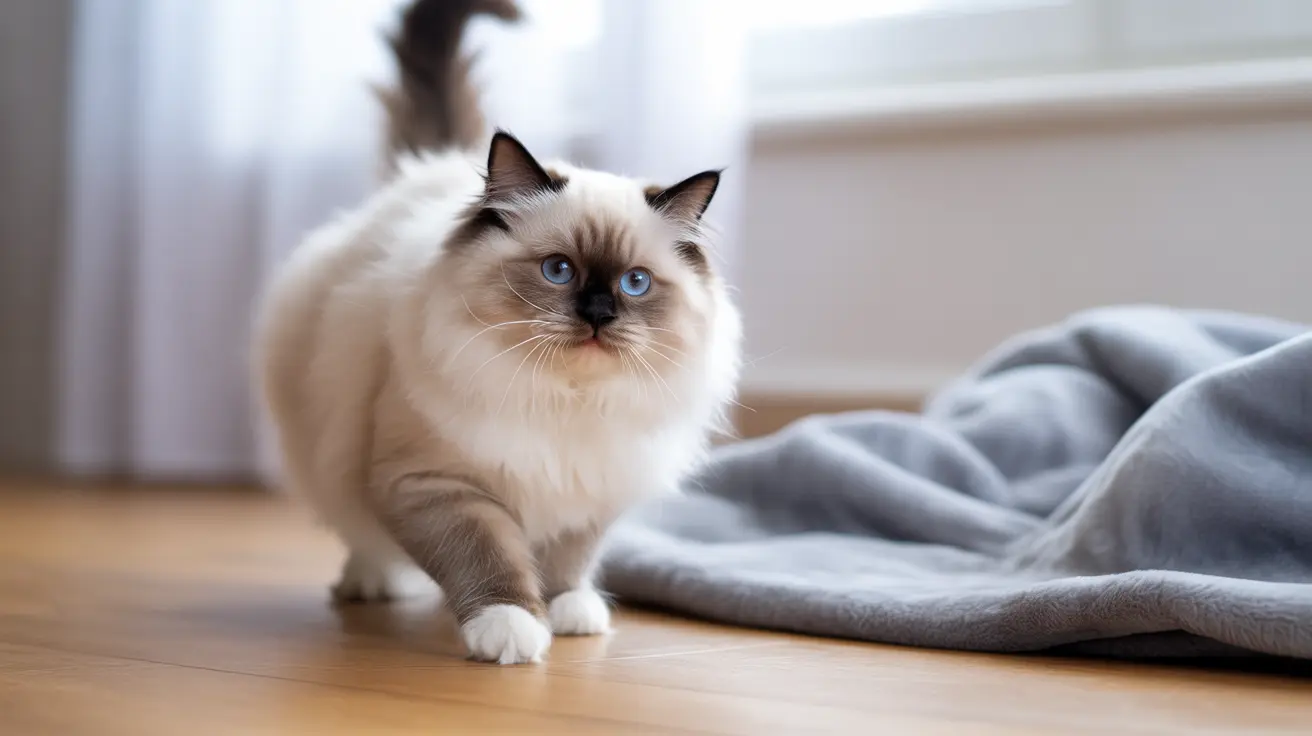Avian Influenza in Cats: Essential Guide to H5N1 Symptoms, Prevention, and Protection
Avian influenza in cats has emerged as a critical concern for pet owners, with the H5N1 strain proving particularly deadly to our feline companions. Since the U.S. outbreak began in March 2024, dozens of cats have contracted this highly pathogenic virus, including barn cats, indoor pets, and even big cats in zoos. Unlike typical "cat flu," avian influenza poses a serious threat with mortality rates reaching up to 70% in infected cats.
Understanding the transmission routes, recognizing early symptoms, and implementing proper prevention measures can mean the difference between life and death for your cat. This comprehensive guide will equip you with essential knowledge to protect your feline family members from this devastating disease while addressing the growing concerns surrounding raw feeding practices and outdoor exposure risks.
Understanding Avian Influenza H5N1 in Cats
Avian influenza A viruses occur naturally in waterfowl, with H5N1 having evolved to infect various birds and mammals. While primarily affecting wild birds and poultry, this highly contagious viral disease has demonstrated a remarkable ability to cross species barriers, making cats particularly vulnerable hosts.
The H5N1 strain is especially concerning because cats appear to be exquisitely sensitive to infection, with current data showing fatality rates between 63-67% for the circulating clade. This exceptional susceptibility means that even brief exposure can result in severe, life-threatening illness that progresses rapidly within 24 to 48 hours.
Why Cats Are Particularly Vulnerable
Cats are considered unusual hosts for avian influenza, but their susceptibility to severe illness sets them apart from other companion animals. The virus can affect multiple organ systems simultaneously, causing pneumonia, brain inflammation, and widespread organ damage. Unlike dogs, which typically experience milder symptoms when infected with H5N1, cats often develop neurological complications that can be fatal.
How Cats Contract Avian Influenza
Raw Feeding: A Critical Risk Factor
Recent investigations have identified food as a primary source of H5N1 infection in cats, with unpasteurized milk and raw or undercooked meat topping the list of dangerous exposures. Raw diets, including retail pet foods containing raw meat, have been directly linked to severe illness and death from H5N1 in both pet cats and captive big cats.
Several pet food manufacturers have issued recalls for raw cat foods contaminated with H5N1, with confirmed cases in New York City and San Francisco involving specific raw cat food brands. The genotype found in these contaminated products matched exactly with that discovered in the affected cats, establishing a clear connection between raw feeding and infection.
Additional Transmission Routes
Beyond contaminated food, cats can contract avian influenza through multiple pathways:
- Direct contact with infected wild birds or poultry and their secretions
- Exposure to infected livestock and their environments
- Contact with infected farm workers and their contaminated clothing
- Ingestion of raw colostrum and unpasteurized dairy products
- Hunting infected wild birds
- Exposure to contaminated surfaces, footwear, and equipment
Indoor cats are not immune to infection, as several cases have been documented in house cats with no direct outdoor exposure. These infections likely occurred through human contact or contaminated items brought into the home.
Recognizing Symptoms of Avian Influenza in Cats
Early Warning Signs
The initial symptoms of H5N1 in cats can appear deceptively mild, resembling common respiratory ailments. Early signs include:
- Fever and elevated body temperature
- Loss of appetite and reduced food intake
- Lethargy and decreased activity levels
- Mild respiratory signs like sneezing
- Nasal discharge
Progressive Symptoms Requiring Emergency Care
As the disease advances, cats develop more severe symptoms that demand immediate veterinary attention:
- Severe conjunctivitis with heavy discharge from eyes and nose
- Labored or rapid breathing
- Blue-tinged gums indicating oxygen deficiency
- Neurological signs including incoordination, circling, tremors, and seizures
- Blindness and other vision problems
- Complete refusal to eat or drink
- Severe depression and unresponsiveness
Advanced Stage Complications
In severe cases, H5N1 can cause inflammation of critical organs including the brain, meninges, lungs, eyes, and heart muscle. These complications often prove fatal, emphasizing the importance of early detection and intervention.
Cat-to-Cat and Zoonotic Transmission Concerns
Inter-Feline Transmission
Whether infected cats can transmit H5N1 to other cats remains unclear, though this possibility cannot be dismissed. One reported case suggests cat-to-cat transmission may occur, though contaminated surfaces and objects (fomites) could not be ruled out as alternative explanations. As a precautionary measure, isolation of symptomatic cats is strongly advised until veterinary consultation.
Human Health Implications
The risk of cat-to-human transmission is currently considered extremely low, with no confirmed cases reported during the current outbreak. However, this risk may increase with prolonged, unprotected exposure to infected animals. Cat owners should limit their pet's contact with immunocompromised individuals if any virus exposure is suspected and follow CDC recommendations for protection.
Human-to-Cat Transmission Possibilities
While not definitively confirmed, human-to-cat transmission appears possible. A recent report documented two indoor cats infected in households of dairy farm workers in Michigan, suggesting potential transmission from humans to cats, though the workers declined viral testing. Transmission via contaminated clothing brought home from infected environments represents another plausible route.
Safe Feeding Practices During Outbreaks
Eliminating Raw Diet Risks
During avian influenza outbreaks, cat owners must completely avoid feeding raw meat-based diets and unpasteurized dairy products. This includes:
- Raw or undercooked poultry, beef, and other meats
- Unpasteurized milk, cream, and colostrum
- Raw meat-based commercial pet foods
- Raw treats and supplements
Safe Feeding Alternatives
Protect your cat by implementing these feeding guidelines:
- Thoroughly cook all meat products to safe internal temperatures
- Choose only pasteurized dairy products if feeding any dairy
- Select commercial pet foods that use cooked ingredients
- Maintain proper food storage and handling hygiene
- Stay informed about pet food recalls and contamination alerts
Environmental Protection Strategies
Indoor Containment Measures
Keeping cats indoors represents the most effective prevention strategy during H5N1 outbreaks. Free-roaming cats face significantly higher exposure risks through contact with infected wildlife, contaminated environments, and infected livestock or poultry operations.
Outdoor Safety Protocols
For cats that must go outside, implement strict protective measures:
- Supervise outdoor time and limit access during known outbreaks
- Prevent hunting behavior and contact with wild birds
- Keep cats away from livestock, poultry, and their environments
- Avoid areas with sick or dead bird populations
- Cover outdoor enclosures to prevent bird contact
Handling Contaminated Materials
When cats bring home dead birds or when cleaning potentially contaminated areas:
- Wear personal protective equipment including gloves and masks
- Use disinfectants effective against influenza viruses
- Dispose of carcasses according to local health guidelines
- Thoroughly wash hands and change clothing after handling
- Disinfect shoes and equipment that may have contacted infected materials
Veterinary Care and Diagnostic Procedures
When to Seek Emergency Care
Contact your veterinarian immediately if your cat displays any combination of fever, breathing difficulties, neurological signs, or severe lethargy, especially if there's potential H5N1 exposure. Call ahead to describe symptoms and prepare the veterinary team for proper protective protocols.
Diagnostic Process
Veterinary diagnosis involves comprehensive evaluation including detailed exposure history, physical examination, and laboratory testing. Suitable samples for H5N1 PCR testing include oropharyngeal or nasal swabs, urine, serum, whole blood, and samples of any raw food consumed. Avoid rapid in-clinic H5N1 tests due to unestablished accuracy for feline cases.
Treatment Approaches
Currently, no cure exists for H5N1 in cats, and no vaccines are available for feline protection. Treatment focuses entirely on supportive care, including:
- Intravenous fluid therapy to maintain hydration
- Oxygen therapy for respiratory support
- Antibiotics to prevent secondary bacterial infections
- Nutritional support for cats refusing food
- Isolation protocols to prevent spread
Public Health Responsibilities and Reporting
Owner Responsibilities
Cat owners play a crucial role in surveillance and prevention efforts. Monitor family members and other animals for signs of illness following potential exposure, and report any human illness to local public health officials. Maintain detailed records of your cat's activities, exposures, and symptom progression to assist veterinary and public health investigations.
Professional Reporting Requirements
Veterinarians must promptly report suspected H5N1 cases to state animal health officials, public health veterinarians, or state veterinary diagnostic laboratories. This reporting supports ongoing surveillance efforts and helps track the virus's spread and evolution in domestic animal populations.
Comprehensive Prevention Checklist
Daily Prevention Measures
Implement these routine practices to minimize H5N1 exposure risks:
- Keep cats indoors, especially during known outbreaks
- Feed only cooked meat and pasteurized dairy products
- Maintain strict hygiene when handling pet food and feeding equipment
- Wash hands thoroughly after any animal contact
- Change clothes and shoes after potential virus exposure
- Monitor local outbreak reports and adjust precautions accordingly
Environmental Management
Create a safe environment by removing bird attractants near your home, covering or relocating bird feeders during outbreaks, and maintaining clean, disinfected living spaces. If you work with livestock, poultry, or in veterinary settings, implement strict decontamination protocols before returning home.
Frequently Asked Questions
Can indoor cats get avian influenza?
Yes, indoor cats can contract H5N1 through contaminated raw food products, exposure to infected humans (such as farm workers), or contact with contaminated clothing and shoes. Several documented cases involve house cats with no direct outdoor exposure, highlighting the importance of preventing all potential exposure routes regardless of lifestyle.
How quickly do symptoms appear after exposure?
Avian influenza symptoms in cats can progress rapidly, with the disease advancing from mild signs like sneezing to life-threatening illness within 24 to 48 hours. Early symptoms include fever, lethargy, and reduced appetite, while serious complications requiring emergency care include breathing difficulties, neurological signs, and complete refusal to eat or drink.
Is it safe to handle a cat suspected of having H5N1?
Handle suspected cases with extreme caution using personal protective equipment including N95 respirators and protective gowning. Limit close contact, especially during aerosol-generating activities like coughing or sneezing. Isolate the cat from other animals and immunocompromised individuals until veterinary evaluation confirms the diagnosis.
What should I do if my cat ate a dead bird?
Contact your veterinarian immediately and monitor your cat closely for symptoms over the following days. Implement isolation protocols to prevent potential spread to other pets, and thoroughly disinfect any areas where the cat may have brought the carcass. Document the incident with dates, locations, and bird species if identifiable for veterinary reference.
Are there any effective treatments for H5N1 in cats?
No specific antiviral treatments or cures exist for H5N1 in cats. Treatment consists entirely of supportive care including intravenous fluids, oxygen therapy, antibiotics for secondary infections, and nutritional support. The high mortality rate of 63-67% emphasizes that prevention remains far more effective than treatment options.
How long should I keep my cat indoors during an outbreak?
Keep cats indoors throughout the duration of local H5N1 outbreaks and continue monitoring for several weeks after the last reported case in your area. Consult with local veterinary and public health authorities for specific guidance based on your geographic location and current outbreak status.
Can H5N1 be transmitted through cooked poultry products?
Properly cooked poultry and egg products do not pose H5N1 transmission risks, as adequate cooking temperatures destroy the virus. However, raw or undercooked poultry products remain dangerous and have been directly linked to fatal infections in cats. Always ensure complete cooking and proper food handling practices.
Conclusion
Avian influenza in cats represents a serious and evolving threat that demands immediate attention from pet owners, veterinarians, and public health officials. With mortality rates reaching up to 70% and rapid disease progression, prevention remains the most critical tool in protecting our feline companions from this devastating virus.
The connection between raw feeding practices and H5N1 infections cannot be overstated, with contaminated unpasteurized milk and raw meat products serving as primary transmission sources. By eliminating raw diets, maintaining indoor containment during outbreaks, and implementing comprehensive hygiene protocols, cat owners can significantly reduce their pets' exposure risks. Stay vigilant for early warning signs, maintain open communication with your veterinary team, and remember that in the fight against avian influenza in cats, prevention truly is the best medicine.






